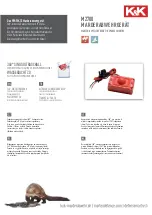
CHANGING A THERMOSTATIC
ACTUATOR ON THREE-WAY VALVES
1. Secure all water to valve and outlet from valve.
2. Drain pipe line below location of thermostatic bulb,
if no well is used.
3. When you are sure the water has been drained and all
internal pressure is relieved, remove the four bulb
bushing screws and take the thermostatic bulb out of
the bulb bushing.
4. Turn the temperature adjustment wheel to the lowest
position.
5. Cool the bulb and bellows at least 20°F (-6˚C) below the
lowest temperature range indicated on the name plate.
6. Remove the bellows housing nuts and screws
and lift unit off bracket.
7. Turn temperature adjustment wheel up sufficiently to
put enough tension on the spring to hold the cold port
shut.
8. Place a spacer 3/32" (2.4 mm) thick (2 pennies) on
upper stem plate and replace bellows housing
(completely cooled) holding it down so flange rests
on ring of bracket. If stem adjustment has not been
disturbed, stem will just move opening cold port.
Remove spacer and fasten bellows housing in place.
9. If stem does not move, unscrew upper stem from
lower stem a turn at a time until this movement is
obtained.
10. Stem should move 1/32" (0.8 mm). Screw upper
stem down on lower stem until this amount of move-
ment is obtained.
11. Lock the two stems in this position with the stem
adjustment lock nut.
12. Attach housing to bracket.
13. Install bulb in pipe line with “top” on top.
7
Figure No. 12
REGULATOR BODY
STUFFING BOX NUT
LOWER VALVE STEM
UPPER VALVE STEM
TEMPERATURE ADJUSTMENT WHEEL
BELLOWS HOUSING NUT
BRACKET
UPPER VALVE STEM PLATE
BELLOWS HOUSING
BELLOWS HOUSING SCREW
ARMORED CAPILLARY TUBING
BULB BUSHING SCREWS
GASKET
BULB BUSHING
THERMOSTATIC BULB
STEM ADJUSTMENT LOCK NUT
CAUTION
ALL SUPPLY VALVES MUST BE
TURNED OFF, SYSTEM PRESSURE
MUST BE REDUCED TO 0 psi (0 bar),
AND SYSTEM TEMPERATURE MUST BE
REDUCED BELOW 100˚F (38˚C) BEFORE
REMOVING THE BULB. FAILURE TO
FOLLOW THIS CAUTION MAY RESULT
IN SERIOUS BURNS.
!
CAUTION
REGULATORS OPERATING LOWER THAN 120˚ - 160˚
(49˚ - 71˚C) OR IN ROOMS ABOVE 100˚F (38˚C), THE
BELLOWS MUST BE COOLED UNTIL IT CAN BE
COMPRESSED BY HAND. FAILURE TO FOLLOW
THIS CAUTION COULD DESTROY THE ACTUATOR.
!
Summary of Contents for Bell & Gossett Hoffman Specialty 1140 Series
Page 11: ...11...






























